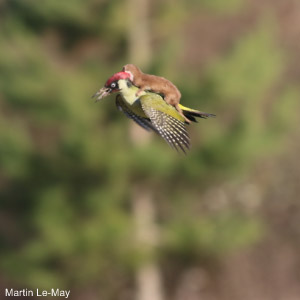Magazine | Analyses
À propos d’une tentative de prédation d’une belette sur un Pic vert

Belette d’Europe (Mustela nivalis) accrochée à un Pic vert (Picus viridis) après avoir voulu l’attaquer, Hornchurch Country Park, Essex (Grande-Bretagne), le 2 mars 2015.Photographie : Martin Le-May
Introduction
Lors d’une promenade dans le Hornchurch Country Park dans l’Essex (Grande-Bretagne) le 2 mars 2015, Martin Le-May et sa femme ont été attirés par les cris d’un Pic vert (Picus viridis). Avec leurs jumelles, ils ont remarqué que cet oiseau était curieusement agité et ils ont repéré des taches jaunâtres et blanches qui semblaient mêlées au rouge de sa couronne. Martin a alors rapidement pris avec son Canon EOS 70D muni d’un téléobjectif de 300 mm f/2.8 quelques photos (en mode programme) du pic qui volait vers lui et qui s’est posé dans l’herbe à 20 mètres. Une Belette d’Europe (Mustela nivalis) s’était accrochée à lui, probablement pour essayer de le mordre. Du fait de la présence des deux observateurs, l’oiseau a pu se réfugier dans un buisson et le petit mammifère est parti.
En revenant chez lui, Martin a constaté qu’il avait réalisé d’étonnants clichés (si spectaculaires que certaines personnes pensent qu’il s’agit de montages), notamment celui où l’on voit la belette sur le dos du pic en vol ! Il les a publiés sur le site web Buzzfeed le 2 mars et ils ont alors aussitôt connu un immense succès. Martin a accepté que nous les publiions ici.
Dans cet article, nous évoquons le comportement prédateur opportuniste de la belette, un petit carnivore aux besoins énergétiques élevés qui chasse des oiseaux (parfois plus grands que lui) quand les rongeurs deviennent rares.
Abstract
During a walk in the Hornchurch Country Park in Essex (UK) on March 2, 2015, Martin Le-May and his wife were attracted by the calls of a Green Woodpecker (Picus viridis). With their binoculars, they noticed that the bird was strangely agitated and that yellow/white colour interspersed with the flash of the red head feathers of the bird. He quickly switched from his binoculars to his camera. The bird flew slightly in his direction and he found that it had a small mammal on its back! Martin quickly took some photos with his Canon EOS 70D (Program Mode). The woodpecker landed in the grass 20 meters away. An European Weasel (Mustela nivalis) was clung to it, probably to bite it. Due to the presence of two observers, the bird was able to take refuge in a bush and the small mammal fled. Once at home, Martin discovered the amazing shots he took, notably one where we can see the weasel on the back of the flying woodpecker (but some photographs thinkit’s a photo montage)! He published them on the Buzzfeed website on March 2 and they immediately had a huge success. Martin allowed us to publish them.
In this article, we speak about of the opportunistic predator behavior of the weasel, a small carnivorous with high energy needs that prey on birds when rodents become rarer.
Poursuivez la lecture de cet article, en vous abonnant dès maintenant !
Découvrez les Archives d’Ornithomedia.com
Pour seulement 10,00 €TTC/an (ou 6,00 € les 6 mois)
Profitez de plusieurs centaines d’articles en accès illimité et sans aucun engagement.
Compléments
À lire aussi sur Ornithomedia.com
Pillage en direct d’un nid de Cigognes noires par une Martre des pins
Sources
- Martin Le-May (2015). Incredible photo sequence shows weasel attack on Green Woodpecker. Date : 03/03. www.birdguides.com/webzine/article.asp?a=4886
- André Boussard (2015). La photo Pic vert-Belette -On en parle… – Et si c’était un montage ? www.oiseauxethologie.fr/php/articles.php?lng=fr&pg=369
- Euan Dunn (1977). Predation by Weasels (Mustela nivalis) on Breeding Tits (Parus Spp.) in Relation to the Density of Tits and Rodents. Journal of Animal Ecology. Volume 46, numéro 2. Pages : 633-652. www.jstor.org/discover/10.2307/3835?sid=21105582876231&uid=3738016&uid=2&uid=4
- P. J. Moors (1975). The food of weasels (Mustela nivalis) on farmland in north-east Scotland. Journal of Zoology. Volume 177, numéro 4, pages 455–461. Décembre. http://onlinelibrary.wiley.com/doi/10.1111/j.1469-7998.1975.tb02245.x/abstract
- Eric L. Walters et Edward H. Miller (2001). Predation on Nesting Woodpeckers in British Columbia. The Canadian Field-Naturalist. Voume 115 (3). Pages : 413-419. www.ericlwalters.org/waltersmiller2001.pdf
- Geir A. Sonerud (1985). Risk of Nest Predation in Three Species of Hole Nesting Owls: Influence on Choice of Nesting Habitat and Incubation Behaviour. Ornis Scandinavica. Volume 16, numéro 4. Pages: 261-269. www.jstor.org/discover/10.2307/3676689?sid=21105582876231&uid=3738016&uid=2&uid=4
- P. Pekkarinen et J. Heikkilä (1997). Prey selection of the least weasel Mustela nivalis in the laboratory. Acta Theriologica (42). Pages 179-188.. http://rcin.org.pl/ibs/Content/12683/BI002_2613_Cz-40-2_Acta-T42-nr17-178-188_o.pdf
- Robbie A. McDonald, Charlotte Webbon et Stephen Harris (). The diet of stoats (Mustela erminea) and weasels (Mustela nivalis) in Great Britain. Journal of Zoology. Volume 252. Numéro 3. Pages : 363-371. http://journals.cambridge.org




 1 commentaire
1 commentaire
1 commentaire(s) sur ce sujet
Participer à la discussion !Pierre Hadjes
BOGOTA COLOMBIE
Posté le 13 mars 2015
Bel article… mais regarder la masse d’ une musarègne étrusque … elle ne se serait bien entendue pas risquée sur un pic vert vu qu’ elle ne se nourrit que d’ insectes…
Bon ces anglaises sont folle, mais on le savait déjà.